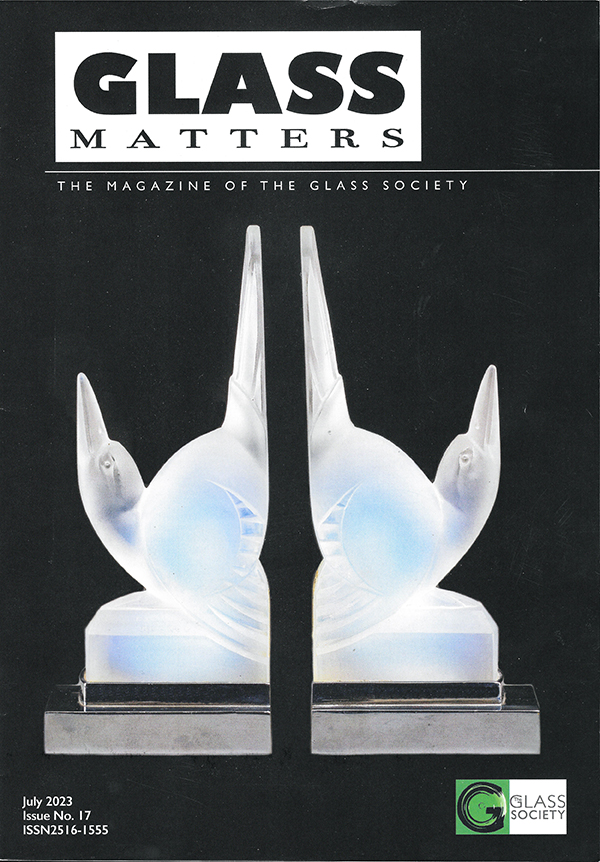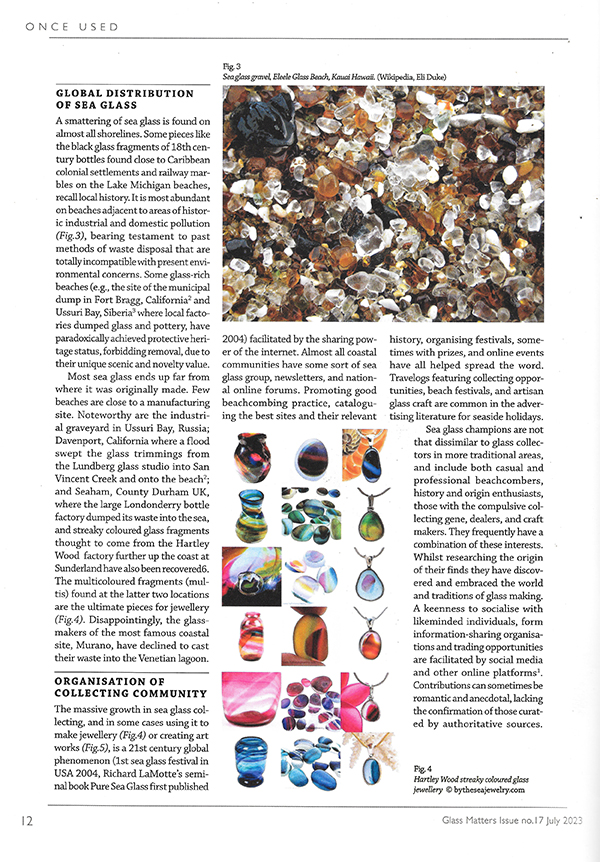Collecting Sea Glass - Glass Matters Magazine
Published July 2023
Glass Matters Magazine - The Magazine of the Glass Society
Article by Roger Ersser




Transcription
COLLECTING SEA GLASS:
Another person’s treasure
Roger Ersser
One person’s rubbish is another’s treasure. Last Summer, a good friend of ours was admiring the beachcombing treasures from our local Hove beach that sit on our patio wall and said she collected sea glass. I obviously gave her a few small pieces we had. I said that I had discovered the North American Sea Glass Association and Seaham beach on the Northeast coast where the glassworks had dumped their waste into the sea whilst researching my articles on recycled glass (The Glass Cone 104,105). She replied that there was an enormous international interest in sea glass especially amongst jewelry makers. That Seaham was in the top 5 world sites for collecting and she wished to go there some day. I made a mental note that a piece of Seaham Jewelry would make a great Christmas present.
In November, when I started an internet search for a suitable piece (a necklace she adores), I found she was correct and a global interest in collecting sea glass had expanded fantastically since my searches a decade earlier. I was in a parallel universe of glass collecting compared to the experiences of most Glass Society Members. There are books, magazine articles, blogs, videos, all sorts of media posts, beach festivals with prizes and a market for found pieces especially for jewelry makers and mosaic type artwork. A specific language has developed to standardize the description of pieces and their origin. I thought and insight into this alternate world, where treasured damaged objects are collected for free, might be of interest to members.
THE ORIGIN AND EVOLUTION OF SEA GLASS
After the mountains of waste left my visitors to popular locations are cleared, most pieces of glass found on beaches originate from everyday manmade glass objects (often broken) which have been either deliberately or accidentally cast into the sea. In contrast to the relatively unchanged archeological treasure recovered from sunken wrecks, most arrive on the shoreline modified by the time spent in this dynamic chemical and mechanical environment. These include last week’s unchanged drinks bottles, distressed objects and shards, unidentifiable pebbles sculptural shaped and tiny fragments amongst the shingle and sand from which they were originally made.
THE ATTRACTION OF SEA GLASS
Glass has little intrinsic value compared to gemstones or precious metals. Factors such as the inventive use of transparent and translucent material., craftmanship, artistic virtuosity, perfect condition, rarity, and provenance attract glass collectors. Most of these characteristics disappear during the prolonged contact with time and tide. The resulting objects are therefore mere curiosities to mainstream collectors.
On the other hand, any natural process that over decades can turn shards of utilitarian glass into jewels (Fig 1) and fascinating sculptural forms (Fig 2) is magic to its hordes of enthusiasts. Ocean worn, still recognizable objects, such as old bottles, bottle stoppers, Codd bottle marbles, glass ornaments and even battered glass electrical insulators and fishing floats are significant social history to some. One spectacular artwork is a large memorial mural made from sea glass collected on Spectacle Island, Boston MA1. Examples found on the beaches of fresh and brackish water tidal rivers and estuaries (beach Glass), beloved by ‘mudlarks’, have a different appearance to those pounded by powerful waves on rocky shores. Commonly considered litter, finds can often be removed free from the beach.
GLOBAL DISTRIBUTION OF SEA GLASS
A smattering of sea glass is found on almost all shorelines. Some pieces like black glass fragments of the 18th century bottles found close to Caribbean colonial settlements and railway marbles on the Lake Michigan beaches, recall local history. It is most abundant on beaches adjacent to areas of historic industrial and domestic pollution (Fig 3) , bearing testament to past methods of waster disposal that are totally incompatible with present environmental concerns, Some glass-rich beaches (e.g. the site of the municipal dump in Fort Bragg, California2 and Ussuri Bay Siberia3 where local factories dumped glass and pottery, have paradoxically achieved protective heritage status, forbidding removal, due to their unique scenic and novelty value.
Most sea glass ends up far from where it was originally made. Few beaches are close to a manufacturing site. Noteworthy are the industrial graveyard in Ussuri Bay, Russia: Davenport, California where a flood swept the glass trimmings from the Lundberg glass studio into the San Vincent Creek and on the beach, and Seaham, County Durham UK, where the large Londonderry bottle factory dumped its waste into the sea, and streaky colored glass fragments thought to come from the Hartley Wood factory further up the coast at Sunderland have also been recovered6. The multicolored fragments (multies) found the latter two locations are the ultimate pieces for jewelry. (Fig 4). Disappointingly the glass makers of the most famous coastal site, Murano, have declined to cast their waste into the Venetian lagoon.
ORGAINZATION OF COLLECTING COMMUNITY
The massive growth in sea glass collecting, and in some cases using it to make jewelry (Fig 4), or creating artworks (Fig 5), is a 21st century global phenomenon (1st sea glass festival in USA 2004, Richard Lamottes seminal book Pure Sea Glass, first published 2004) facilitated by the sharing power of the internet. Almost all coastal communities have some sort of sea glass group, newsletters and national online forums. Promoting good beachcombing practice, cataloguing the best sites and their relevant history, organizing festival, sometimes with prizes, and online events have all helped spread the word. Travelogs featuring collecting opportunities, beach festivals, and artisan glass craft are common in the advertising literature for seaside holidays.
Sea Glass champions are not that dissimilar to glass collectors in more traditional areas, and indclude both casual and professional beachcombers, history and origin enthusiast, those with the compulsive collecting gene, dealers and craft makers. They frequently have a combination of these interests. Whilst researching the origin of their finds they have discovered and embraced the world and traditions of glass making. A keenness to socialize with like minded individuals, form information sharing organizations and trading opportunities are facilitated by social media and other online platforms1. Contributions can sometimes be romantic and anecdotal, lacking the confirmation of these curated by authoritative sources.
STANDARIZATION OF LANGUAGE
By dividing the origin of the glass into major groups, e.g. vessel; Utilitarian; art; industrial and raw and standardizing the names given to the different shapes and colors, and types of material, a universal descriptive language has developed. The pioneering US based, International Sea Glass Association (formerly The American Sea Glass Association founded in 2006)4 , publications like Beach Combing magazine (and its predecessor Glassing)2 the online Sea Glass Journal1, books – Amazon lists over 20 published in the last decade – glossaries, wall charts, and beach guides devised by experienced collectors and jewelry makers such as Linda Jereb’s comprehensive website3, have all made significant contributions to this evolution.
MODIFICATION AND FAKES
Some collectors indulge in the questionable practice of returning pieces to the sea for further modification, or ‘seeding’ with rarer objects and colors for future discovery. Post collection treatment is sometimes applied, especially by jewelry makers. Irregular blemished pieces can be tumbled into more pleasing shapes and surfaces, They can be oiled to enhance translucency.
With high quality desirable finds becoming rarer, beach removal restrictions increasing, and traders’ prices increasing, fulfilling the demands of jewelry makers and artists is taxing. This has resulted in ‘fake’ and ‘modified’ material in circulation. Acid etching can be used. Virgin glass shards are transformed by mechanical agitation with abrasives and chemical solutions, in bulk by factories in Germand and China, on a smaller scale using stone tumbling mills, or even in back gardens cement a mixer! Chemical leaching (hydrations), mineral staining and crizzling are difficult to reproduce convincingly, whilst shapes are easier to replication. These lookalike impostors are attractive to home hobbyists and homeware and lifestyle companies wishing to achieve a maritime vibe.
The International Sea Glass Association has a large number of members who sell sea glass products. They have introduced criteria for the origin of the material and acceptable product processes to which they must adhere to call them authentic sea glass items. These rules also apply to shards entered for festival prizes. Similarly, well established sea glass artists such as Linda Jereb (Fig 4) and Rachel Bellman (Fig 5) insist on untouched material despite it becoming harder to source.
FUTURE
Is is difficult to speculate if and when this current frenzy in the sea glass world will subside. The jewelry market seems close to saturation and will contract in volume and value as fashion moves on. A decline in desirable material will make dealing less profitable. During the recent pandemic, Seaham traders complained that an influx of staycation visitors was affecting the volume of their finds! (BBC Tyne and Wear). The hobbyist beachcomber will, as before, continue to fill their jars , history and origin will still fascinate others, sea glass will remain in repertoire of coastal artisan, whilst the dilettante follower will depart to blog the next trend. I hope Glass Society members will take a closer look at the shoreline next time they are strolling along the beach. Who knows you could find a car taillight ‘ruby’ Mateus Rose teal ‘emerald’!
With special thanks to our friend Auri Millar for her insight and inspiration.
REFERENCES
- Seaglassjournal.com
- beachcomingmagazine.com
- siberiantimes.com 30th Jan 2017
- seaglassassociation.com
- bytheseajewelry.com (Linda Jereb)
- Hunting for Seaham Sea Glass (thisisdurham.com)
- Seaglassart.co.uk (Rachel Bellman)
BIBLIOGRAPHY
- Pure Sea Glass: Discovering Natures Vanishing Gems, Richard Lamotte and Celia Pearson; Schiffer Publishing Lts. 1st published 2004 latest edition 2019
- Wikipedia: Glass Beach, Eleele, Hawaii
- BBC News, Tyne and Wear, 30th March 2021
'Glass Matters' Magazine is a publication put our by The Glass Society https://www.glassassociation.org.uk/
